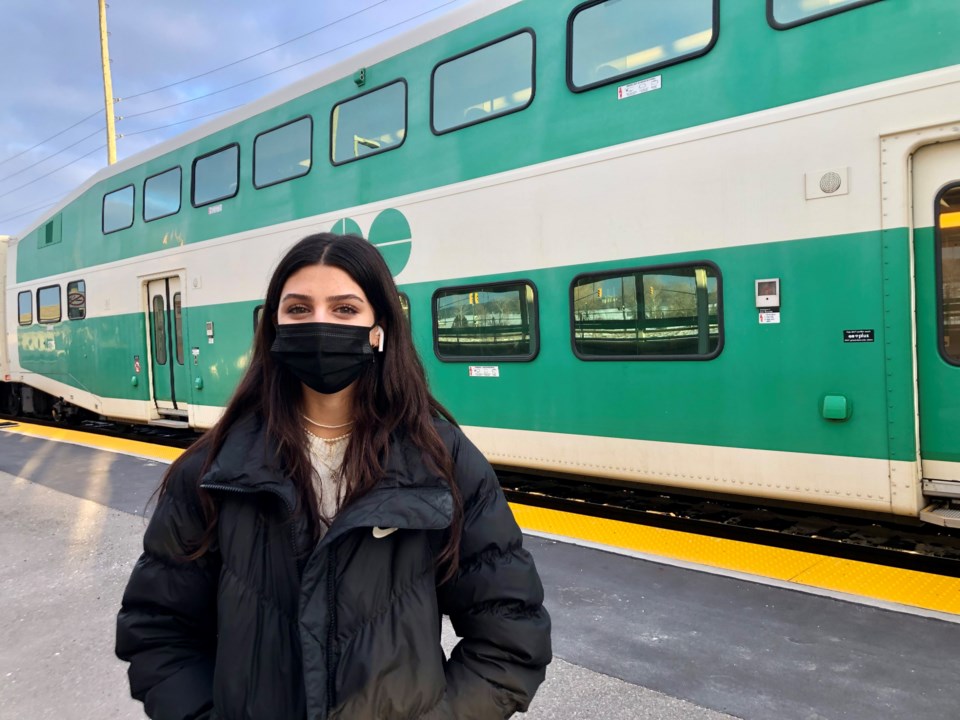A one-two punch of ever-rising gas prices and a slow return to pre-pandemic life is prompting an exploration into the alternatives.
Electric cars, for instance, are attracting attention, even as gas prices could reportedly be coming down in the next few days.
Public transit ridership, largely dormant during parts of the pandemic, is also climbing closer to what would be considered normal numbers.
Highway speed has even slowed down, said a commuter who identified himself as Glenn. Working in the trades means hitting the road by 5 a.m. for the start of the 180-kilometre round-trip commute. So public transit is out of the question, he said, although the Innisfil man hopes one day to see more GO train service.
In the interim, he said he prefers carpools with another commuter.
“Everyone’s adjusted their driving, for sure. I’ve noticed that on the 400,” said Glenn, adding most vehicles on the road are occupied by single commuters, leaving plenty of space in the newly opened carpooling lanes. “People aren’t riding up behind you trying to go around you going 140, 150 (km/h) anymore, at least that I’ve noticed.”
GO train ridership took a hit during the pandemic and Metrolinx reduced the number of trains leaving Barrie — which travels through Newmarket — in the morning and returning in the evening. The transit agency is reporting overall ridership in January was at 11.2 per cent of pre-pandemic levels, rising to 25.9 per cent by the end of February.
There is a correlation between high gas prices and transit ridership, said Marco D’Angelo, CEO of the Canadian Urban Transit Association.
A pre-pandemic study found that for every 10 per cent rise in the price of gasoline, transit use increased by 1.4 per cent.
Fewer pandemic-related restrictions are bound to increase transit use, he added.
While gas prices play a role, D’Angelo said he expects that all the costs related to car ownership, such as insurance and maintenance, also help point travellers in the direction of public transportation.
“Public transit is really the affordable way,” he said.
And it continues to develop, D’Angelo said, referring to a recent announcement of a $750-million federal government investment.
One rider said it does seem that more people are taking the train of late.
“Especially on this train that I took on the way back, it’s so full it’s hard to find a seat,” Anushka Aujla-Letts said after disembarking in Allandale on Tuesday afternoon.
The York University law and society student, who has been commuting three times per week by train since January, said there seem to be more people her age riding the train now that class is back in.
For those who want to remain behind the wheel, electric cars are another option.
Ron Fischer has been fielding more calls from people wanting to know about electric vehicles (EV) and the options. The owner of Allandale Technologies, which provides EV charging and infrastructure, said many sitting on the fence are now piqued by the prospect of paying less to drive — particularly commuters.
Fischer, who has had a Chevy Bolt since 2017, is a full-on EV fan.
In fact, he tells commuters exploring their options to go full electric — plug-in hybrids are OK for short jaunts within the city, but rely too heavily on gas for longer drives.
“Joe average public… they want to talk to someone real,” Fischer said of the calls he has fielded.
The upside is that electric cars aren’t as expensive as they once were and, with federal rebates, now compare price-wise to gas vehicles, he added.
But the downside is supply-chain issues have limited the supply of new vehicles available for purchase at car lots, and that includes access to EVs.
Fisher figures he spends about $3.50 for a full charge that takes him 420 kilometres in the summer and about 350 in the winter.
Gas prices were about $1.85/L Wednesday, up about one-fifth of a cent since last week, and are expected to continue to rise.
Russia’s attack on Ukraine has resulted in an uncertain market and bans on Russian oil with expectations that prices will rise further.



